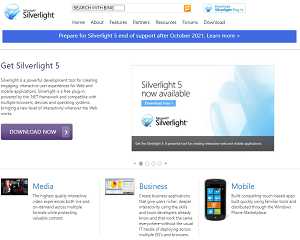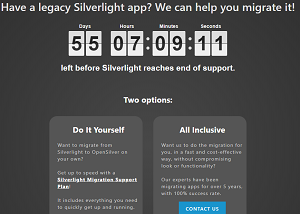News
A Decade Later, .NET Developers Still Fear Being 'Silverlighted' by Microsoft
Some 10 years after the final Microsoft Silverlight release, some developers still fear being "Silverlighted," or seeing a development product in which they have invested heavily be abandoned by Microsoft.
Microsoft will tell you that official support for Silverlight will end in less than two months, on Oct. 12, 2021. Anyone in the industry will tell you it effectively died around 2011 when the last version, Silverlight 5, was made available for download. Speculation about its demise arose around the same time.
Silverlight is described by Wikipedia as an application framework designed for writing and running Rich Web Applications, supporting multimedia, graphics and animation. It became a favorite tool for many developers, including this reporter, who created a spiffy blackjack card game in which Silverlight animation was used to make the playing cards spin and flop through the air as they were dealt from the deck to the playing surface. It was cool.
 [Click on image for larger view.] Silverlight (source: Microsoft).
[Click on image for larger view.] Silverlight (source: Microsoft).
Hello HTML5, Goodbye Silverlight
Many real developers felt the same way and invested themselves in Silverlight, only to see Microsoft deprecate the plugin technology in favor of emerging standards like HTML5. Although still officially a supported product, Silverlight effectively died years ago as browser after browser has dropped Silverlight support, basically leaving only Internet Explorer 11 on Windows as the sole browser it still works with.
 [Click on image for larger view.] IE 11 Stands Alone (source: Wikipedia).
[Click on image for larger view.] IE 11 Stands Alone (source: Wikipedia).
As an old Microsoft FAQ states: "Silverlight 5 is the only version currently supported. Silverlight 5 will support the browsers listed on this page through October 12, 2021, or through the lifecycle of the underlying browsers, whichever is shorter." It turns out that the latter was shorter as clicking on the "this page" link in the above text just goes to a "Get Microsoft Silverlight" site where apparently anyone not using IE 11 on Windows is told: "You are running on a browser that may not be fully compatible with Microsoft Silverlight. You can still try to install by clicking below or you can refer to the System Requirements for more information."
 [Click on image for larger view.] No Silverlight for You (source: Microsoft).
[Click on image for larger view.] No Silverlight for You (source: Microsoft).
So it's dead already, for all practical purposes, and it joins a host of other development products deprecated by Microsoft. Many enjoyed and even still enjoy strong developer support. It's a subjective thing, but some of these products might include Visual Basic, Microsoft Liquid Motion, Microsoft Blend, Microsoft WebMatrix, Microsoft LightSwitch for Visual Studio and Microsoft Expression Web (and maybe toss UWP into the mix).
The latter item in the above list, Expression Web, was even the subject of its own article ("Microsoft Abandons Expression Web and Front End Web Development") in which Silverlight was mentioned many times. For example, one comment in the 2012 article said: "Haven't you heard the .NET developers' outcry a year ago about MS moving the application development focus from .NET to HTML/JS/CSS? Haven't you heard the angry Silverlight developers?"
Also back in 2012, many Visual Studio Magazine readers reacted to the impending demise of Silverlight, with one stating:
I convinced my company to use Silverlight in a very important product. The investment was tremendous, including manpower and learning processes. When we were in the middle of implementation, Microsoft dropped the bomb about the future of Silverlight. I cannot describe the feelings of betrayal and frustration -- not to mention the pressure coming from the upper management team. Now we cannot go back to undo our investment. As a developer, my questions are very simple: Why did Microsoft do such a strange thing to lose the trust of developers? Why can't Microsoft simply continue supporting/advocating Silverlight and, at the same time, advocate future HTML5 as a new trend and development path? As a developer, I feel Microsoft has a lose/lose strategy ... I've stopped advocating any new technologies from Microsoft.
Now, eight years after that, this reporter was reminded twice within the last week that the anger persists. Both reminders came in comments to online articles.
'Will It Be the Next Silverlight?'
The first reminder came in reader comments in a Microsoft post about ASP.NET Core updates in .NET 6 Preview 7. A reader said he would need several things before he would use Blazor (web dev primarily with C# instead of JavaScript):
- Better IDE Support. VS Mac is horribly slow, and VsCode simply doesn't work with Blazor. 99 percent of the time I have no IntelliSense or the pages show squiggly lines everywhere.
- Better performance (it's very easy to make mistakes that make the applications very show, and it's hard and time-consuming to fix it, if at all possible)
- A good component library officially supported by MS, like Angular Material is supported by the angular team. There are a couple of component projects out there, but they are just too young/unstable to be used in large projects/products. [See more on that topic in the article "So Why Doesn't Microsoft Provide Its Own Blazor Component Library?"].
- Better ecosystem. Since blazor is still relatively new, and the community small, the number of packages available is minuscule when comparing with Angular, React, or even Vue.
- Better guidance and realistic example applications using it. The template projects are just too basic, and the pizza delivery apps are not much better.
After that list, the developer commented: "Don't get me wrong, I really enjoy Blazor. But it still has ways to go until it can compete with other technologies, and I'm not sure how sure/committed MS is with it (will it be the next Silverlight?)."
'MAUI Will End Up in the Same Place as Silverlight'
The other reminder came four days ago in the Visual Studio Magazine article "Microsoft Replaces Xamarin Toolkits with New .NET MAUI Alternatives."
The open source .NET Multi-platform App UI (MAUI) is a cross-platform framework for creating native mobile and desktop apps with C# and XAML, described by Microsoft as the evolution of Xamarin.Forms.
While one commenter thought "This is cool!" other developers disagreed, with one retorting: "MAUI will end up the in the same place as Silverlight or UWP... Mark my word!"
So, some 10 years later, within a few days of each other, two developers have expressed about someone being "Silverlighted" (a spiffy new term actually coined by this reporter).
That striking coincidence speaks to the popularity of Silverlight. Even though some might argue that Microsoft's Silverlight deprecation was a sound business decision as the industry drifted away from the plugin approach (Flash, anyone?) in favor of more open, accessible tech like HTML5, Silverlight is still very much in the minds of many developers.
 [Click on image for larger view.] The Countdown (source: Userware).
[Click on image for larger view.] The Countdown (source: Userware).
Silverlight Replacements
Just last year, for example, Userware, on a years-long quest to bring back Silverlight, announced an open source implementation of Silverlight based on WebAssembly called OpenSilver. Underneath a clock counting down to the end of Silverlight support in October, developers are told they have two migration options: do it yourself or sign up for "cost-effective" help (see graphic above).
Two years earlier, Userware had proposed another Silverlight replacement, CSHTML5, also based on WebAssembly, so it appears that may have morphed into the OpenSilver project.
There is even a site for Microsoft Silverlight Competitors and Alternatives.
However, the Silverlight replacement space might be thinning out. For example, on a Citrix forum last year, a developer asked about Any news on silverlight replacement? He said: "Hey, I would like to bring up this very old topic. Customers are looking for a HTML5 GUI for the ELM for a long time now. Is an update of the GUI still on the roadmap? And if so, when is it going to be released?"
To that question, there were no answers, merely more questions spaced out over subsequent months:
- No comment at all? (September)
- /push Any update on this? (November)
- any update on this? *bump* (February 2021)
- Still no news on this? (May 2021)
In other words: <crickets>.
It remains to be seen what other replacement options emerge as the end-of-support countdown steadily approaches zero in a couple months.
Let It Go
Of course, all development tooling companies will come up with new products and technologies and then phase many of them out as the result of business decisions. Perhaps the most reasoned thinking about the fear of being "Silverlighted" came from Ed Charbeneau, then a Developer Advocate for Telerik, in a 2015 blog post titled "Microsoft Hates Enterprise Developers?"
Charbeneau, in discussing changes in ".NET Core 5" (which turned out not to be a thing, as .NET Core became just .NET), did not think that Microsoft hated enterprise developers, whom he basically advised to roll with the changes:
"Spend less time worrying about who Microsoft hates or what language or framework is declared dead this week. Instead, embrace progress, engage in active self-improvement and education. Be the person who abandons the old way of thinking, be more productive, be cross platform, be open source. If you do, you'll find yourself armed with a unique set of skills, ready to solve the problems of tomorrow instead of idly working on problems from the past."
 [Click on image for larger view.] Let It Go (source: Telerik).
[Click on image for larger view.] Let It Go (source: Telerik).
Tellingly, the above words appeared right below a Microsoft Silverlight graphic combined with another graphic that said, "IT SOUNDS LIKE YOU NEED TO LET IT GO."
About the Author
David Ramel is an editor and writer at Converge 360.